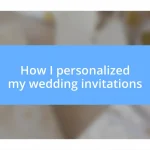Key takeaways:
- RSVPs are crucial for effective event planning, providing clarity on attendee numbers and enhancing guest anticipation.
- Choosing the right RSVP method tailored to guests’ preferences, such as phone calls, group chats, or online tools, can simplify communication.
- Following up on RSVPs with friendly reminders and personal touches fosters engagement and can transform initial hesitations into confirmations.

Understanding RSVP Importance
RSVPs are more than just polite gestures; they are essential for planning and organization. I remember the time I hosted a small dinner party but was left anxiously waiting for replies. The uncertainty created so much stress! How can we create an enjoyable experience without knowing who’s coming?
From my experience, knowing the number of attendees makes all the difference in preparation. You don’t want to end up with too little food or overly cramped seating. It’s about ensuring everyone has a great time, right? When I finally nailed down my RSVPs, it was like a weight lifted off my shoulders.
Moreover, RSVPs provide a sense of commitment from guests. When people confirm attendance, it builds excitement and anticipation for the event. Have you ever noticed how the atmosphere shifts when everyone is on the same page? It turns an ordinary gathering into a memorable occasion.

Choosing RSVP Methods
Choosing the right RSVP method can significantly impact the ease of planning your event. I’ve tried a few different approaches over the years, and I’ve found that the key is to select a method that aligns with your guests’ preferences. For instance, while some might appreciate a simple phone call, others might prefer the convenience of an online platform. It’s all about what feels most natural!
In my last experience with a birthday party, I opted for a group chat on social media. It was pretty effective since everyone was already connected there, but I quickly realized not everyone checks their messages regularly. This led to a few surprises on the day of the event! So, I learned the hard way that while social media can be fun and engaging, it may not always yield the best communication.
I also experimented with traditional paper invitations, which offered a more personal touch but required a lot of effort. There’s something special about receiving a beautifully crafted invite in the mail. I noticed that it sparked conversations and excitement among friends, but it meant waiting longer for replies. Each method has its pros and cons, and considering your guests’ habits and your event’s tone can guide you to the best choice.
| RSVP Method | Pros |
|---|---|
| Phone Call | Direct and personal contact. |
| Group Chat | Instant replies; convenient for tech-savvy guests. |
| Online Form | Email and tracking options for all responses. |
| Paper Invitations | Elegant and personal, encourages excitement. |

Setting RSVP Deadlines
Setting an RSVP deadline is a crucial step in any event planning process. I usually recommend setting it about two weeks before the event date. This timeframe gives your guests ample opportunity to check their schedules, but it also ensures you’re not left in limbo for too long. I remember a time when I set the deadline too close to the date, and the last-minute rush led to miscommunication and stress—definitely not the vibe I wanted for my gathering!
Here are a few tips for establishing those important RSVP deadlines:
- Consider the type of event: Larger gatherings might need a longer notice to adjust for headcounts.
- Account for your guests: Think about how busy they are—do they need more time to commit?
- Factor in logistics: If you need to book a venue or caterer, earlier deadlines help finalize plans without headaches.
By creating these boundaries, you’ll foster a sense of urgency among your guests, while also letting them know you value their attendance.

Organizing RSVP Responses
When it comes to organizing RSVP responses, I’ve found that keeping a centralized document makes all the difference. Last year, I created a simple spreadsheet that tracked who had responded, their plus-ones, and any dietary preferences. This way, I had everything at my fingertips, reducing the chaos of flipping through multiple message threads or trying to remember who said what. Doesn’t it feel great to have clarity when planning?
One thing I learned is the importance of follow-ups. After my last event, I realized some guests hadn’t responded by the deadline, which left me scrambling! A gentle nudge through a text or email not only reminds them but also shows that you genuinely care about their presence. I sometimes wonder: how many people would have appreciated that extra prompt if it had come from me sooner?
To streamline things even further, I categorized responses in my spreadsheet. Yes meant confirmed guests, maybe for those who were still deciding, and no for those who couldn’t make it. This visual representation was immensely helpful in gauging the overall turnout. It’s surprising how a little organization can transform what often feels like a daunting task into a manageable one, don’t you think?

Using Technology for RSVPs
When I first began using technology for RSVPs, I was genuinely amazed at how it simplified the whole process. I turned to event platforms—like Evite and Paperless Post—that not only let me send out invitations but also allowed guests to RSVP with just a click. It felt like I was living in the future! Have you ever received an RSVP that felt like a chore for your guests? That’s why I love these tools; they make it effortless for everyone involved.
One time, I hosted a wedding shower, and I decided to utilize an online RSVP tool. The instant notifications that popped up whenever someone replied were exhilarating! It felt like hosting a collective event, even if everyone was responding from their homes. My friends appreciated being able to see who else would be attending as well, which sparked discussions and excitement leading up to the event. Do you remember the anticipation before an event, fueled by knowing who you’d see? Technology can definitely enhance that experience.
Of course, using technology doesn’t mean giving up on the personal touch. I’ve found that incorporating a friendly follow-up message through the same platform helps maintain a connection. Once, I reached out to guests who hadn’t RSVP’d and included a little note about how much I would love to see them there. The responses I received were heartwarming! It’s incredible how a simple gesture can remind people of their importance in your gathering. How do you connect with guests when planning your events? Sometimes, that added effort can genuinely elevate the experience for everyone.

Communicating with Guests
Staying in touch with guests during the RSVP process really makes a difference. I remember one dinner party I hosted where I took a few moments to reach out personally to each guest via text. Sharing a bit of my excitement about the gathering helped set the tone and made them feel valued. Have you ever noticed how just a few kind words can spark anticipation?
Additionally, providing guests with updates as the event approached was crucial. For my last birthday celebration, I sent out a reminder a week before, along with a sneak peek of the menu and the evening’s activities. It was heartening to receive replies where guests expressed their excitement! It’s interesting how simple communication reinforces the bond and enhances the guest experience, don’t you think?
I also learned the power of creating a group chat for closer friends attending a casual get-together. We exchanged ideas about decorations, music playlists, and even shared little inside jokes. This connection kept everyone engaged and made the event feel like a collaborative effort. I often ask myself: how can we make our gatherings more inclusive? Finding ways to involve guests can turn an ordinary event into something truly memorable.

Following Up on RSVPs
Following up on RSVPs is both an art and a science, and I’ve learned that a friendly nudge often works wonders. I once had a gathering where a significant number of guests didn’t respond until I personally followed up a few days before the event. I texted each one with a casual reminder that I’d love to see them, and that little effort sparked a flurry of replies. Hasn’t it happened to you where a gentle reminder turned a maybe into a yes?
I also found that timing is key in follow-ups. For my niece’s birthday party, I sent a quick message two days prior, checking in to see if everyone was still planning to come. What surprised me was how many guests appreciated that! Many expressed their excitement and even asked about bringing a plus-one. Isn’t it funny how a simple message can transform the vibe and open up more opportunities for connection?
Lastly, I like to keep my follow-up communications light-hearted and enjoyable. I often add a fun GIF or a little inside joke relevant to the event in my messages. This approach not only breaks the ice but also reminds guests of the good times we share. How do you think humor impacts the way people respond? My experience shows that a touch of playfulness can turn potential awkwardness into delightful anticipation.














